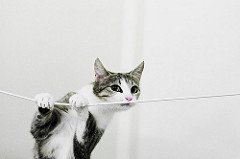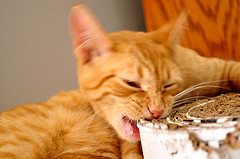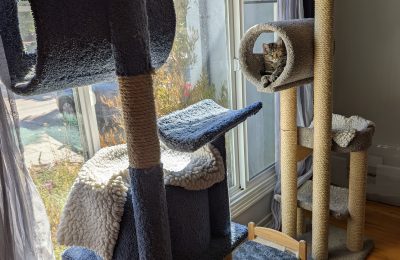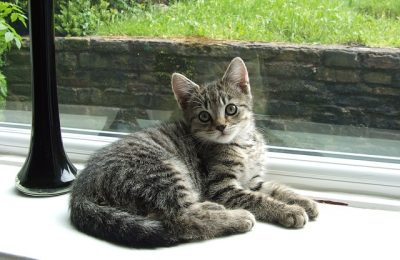Pica, or the ingestion of non-food items, is found in species as varied as parrots, humans, and domestic cats. It’s unclear why some animals eat things that aren’t food – some guesses include stress and nutritional deficiencies. This behavior in cats was first noticed in Siamese cats, who are prone to sucking and eating woolen items. However, once all breeds (including the domestic shorthair) were included in studies, it became apparent that this behavior isn’t limited to the meezers in any way.
A new study, Characterization of pica and chewing behaviors in privately owned cats: a case control study, sought to better understand factors that might predict pica in cats, in the hopes of helping the veterinary community in developing effective treatments. This study surveyed 91 pet owners with cats who ingested non-foods, and included a control group of 35 cats who did not.
The researchers asked questions about basic kitty demographics, including age, breed, sex, medical history. They also included questions about the environment (including types of enrichment available, other people and animals in the house, and access to the outdoors). Finally, they asked questions about potential gastrointestinal signs, such as vomiting and diarrhea.

All cats in the pica group ingested non-food items, with 79 of them also chewing (but not swallowing) other things on a regular basis. Twenty one out of thirty-five of the control cats (that’s 60%) also chewed on things that aren’t really chewables!
What do cats with pica like to “eat?” Perhaps not surprisingly, shoelaces, plastic, and fabrics were all in the top three. Other interesting choices included toilet paper, soap, ear plugs, kitty litter, and sponges. Plastic, paper, rubber, and wood were the chew-toys of choice for the cats who were chewing on items.
Three variables were prominently related to the presence of pica – the first was access to the outdoors. Although pica in cats has often been blamed on being kept indoors and bored, in this study, the pica cats were MORE likely to have access to the outdoors.
Fifty-one percent of the control cats had “ad libitum” access to food – meaning that food was freely available. This was only true for 30% of the pica cats, even though there were no differences in feline hunger ratings by owners between the two groups. Does having food freely available redirect some of that chewing behavior toward food?
Finally, more vomiting was found in the pica cats – but we have a chicken and egg problem in that we don’t know if the vomiting is caused by the chewing, or the chewing is an attempt to relieve nausea. This manuscript opens up interesting research questions about the behavioral signs of gastrointestinal disease, but also suggests that pica is not (at least in all cats) necessarily a stress-related or compulsive disorder caused by indoor housing.
The choices for chewing and eating are interesting to me – we still don’t know why things like plastic and fabric are so darn attractive to cats. And soap? Really? And although we don’t know the prevalence of true ingestion of non-food items in the general population of cats, it’s apparent that chewing behavior in cats is very common (60%) even in a control group of cats!
Pica in cats can be dangerous – in some cases, it can lead to expensive surgeries for gastrointestinal blockage. Pica and chewing can also cause damage to your war

Photo via Flickr/Creative Commons by Jessica Fiess-Hill
drobe, but of course, the burning question is – what does it mean? Is pica a sign of emotional distress or physical pain? Is it a nutritional deficiency? Is it brain chemistry gone awry? Do cats just need appropriate chew toys? Still so many questions!
If you see your own kitty chewing or eating something that isn’t food, be sure to let your vet know before you have an emergency on your hands! In the meantime, this study chips away at the pica mystery, and brings up some interesting questions about how we feed and house our cats.




Thanks for another great article, Mikel! Out of my five cats, I have one who LOVES to lick plastic grocery bags and ziploc baggies. She doesn’t eat them, but it’s very curious! Anyway, pica has always been a mystery to me, and I generally treat it as a stress-related disorder. The results of the study you cited are interesting in that pica is not necessarily indicative of stress related to being kept indoors! The mystery continues, I suppose… 🙂
Thank you Marci, and yes, as always the mystery continues…. 🙂
Our cat licks the couch, eats our straw that is in our drink, and eats our dental floss right out of our hands as we are flossing our teeth. When I learned about pica, I found a 1991 article, Feeding and Drinking Behavior Problems, that indicates pica in cats might be due to early weaning. The new articles suggests pica is not due to early weaning, and we suspected new research would contradict the 1991 article.
things are usually more complicated than we think! I think pica is a good example of that.
So interesting to me. I have two cats, brother & sister, that I’ve had together since they were 8 weeks old. They’re 3 and a half now. The boy cat, Vinny, is an orange Tabby & definitely has feline pica. He goes crazy over plastic shopping bags and also bows and ribbons. The female, Summer, is a calico, and she’s never chewed on anything but her food. So I have kind of my own controlled study I guess. They’ve been raised exactly the same way, same place, same food. Do they grow out of this?
Lisa,
Unfortunately we don’t know if pica improves with age without interventions! However, some cats do improve with chew toys and other enrichment to keep them stimulated.
Mikel
I have a new mom that was taken in a pregnant stray. Part of this will be learned behavior and the other a mystery but I thought the connection may be interesting. I have a small fishtank on my bathroom counter. With hindsight, momma wasn’t after the fish but the water being filtered outside to inside. Before realizing this, momma learned she could even wake me up with the slightest sound of the top moving. It was her attention seeking way to rattle me running to the rescue of my fish. I used packing tape upside on the counter and secured the top with duct tape. Now it was rescuing momma from trying to tear the tape down. Well needless to say the tape had to be removed. Then she realized there was tape on boxes, glue on envelopes and finally cardboard to chew. She doesn’t eat the cardboard just chew. Once she found cardboard the tape fetish stopped and envelopes weren’t really her thing. I don’t go running and it’s not very often. The fact that the vacuum comes out more often may be her deterent! With her being a new mom of course I was worried about her having a mineral deficiency but the learned pattern is so right there.
Attention is such a huge reinforcer for many cats! -Mikel
Perhaps the study should include hormonal changes since pica is common during pregnancy in humans. I loved toothpaste during my second pregnancy which was my only “girl” pregnancy. I didn’t have it with the boys. My Haze (male cat) chews with intentions of digesting anything rubber.
That is fascinating!
Really interesting.
I did a small study on Pica (just 37 cats at all) on my own when doing my exam for feline behaviorist.
I also found, that not only indoor cats but cats that can go outside whenever they want and even are good hunters can have Pica. That really seems to put away the theory of the bored indoor cat.
Another interesting finding was: Some households seems to be kind of “Pica-households”. When there is a cat that has Pica and a new cat is coming into the home, she also shows the behavior after a short time. It could be learning. Especially, if it is a kitten coming into the household. But also older cat shows Pica when coming new into these households. And some owners reported, that there old – now gone – cat had shown Pica and now the new one shows it as well! So I wonder, if there might be something in the house (some smell, some fabrics..?) or in the behavior of the owner (attention?) which triggers the Pica behavior. That is an interesting thing to look on in further studies.
Otherwise the “attention”-theory didn’t fit in as well, because a lot of owners reported, the cat shows Pica when there is nobody around and they will notice it when coming home, seeing things destroyed.
So it is still a riddle and a big challenge for us feline behaviorists to solve Pica.
Sometimes it could help to feed them row muscle and bones to chew on. In some cases you can reduce the problem, if you are lucky, but more often the cats will still show Pica in some circumstances.
I’d love to read your study! Has it been published?
Our big orange male tabby chews up rubber flip flops. Seriously, you leave your flip flops lying around at your peril in summertime. He chews them to bits, but does not appear (we hope) go ingest any of it, based on the bits we find on the floor (we give him old flip flops that have broken). He has access to the outside via his own door and access to dry food at all times.
Raven is my 9 year old domestic short hair. She’s had issues with chewing and pica since the day she came to live with me when she was 3. I have found she has a desire and even obsession to chew on hair ties, croc shoes, faux leather hand bags, nerf darts, and softer flip flops. She will ingest these items which has cause a vet hospital stay with a few enemas to get a nerf dart out. When she sees one of these items she get obsessive and will steal the item and run away. She only recently has showed an interest in going outdoors and will only do so in short outings. We try to keep these items up and away from her, but with kids accidents happen. She has been in my home and my parents home for the last 6 years with people, dogs, and another cat at my parents house until he passed away. She gets playful for short spurts and most if the time shes just wants to lay next to you and be pet. I’m not sure of her history prior to living with me. But if there is an open box or plastic laundry basket, she will pee in either. She’s an interesting cat forsure.
I have a 1.5 yr old male Singapura who has exhibited every sign of pica since I brought him home 1.2 yr. ago. Frankie began this activity by taking soft toys to his food bowl and making prey out of them by chewing on them while consuming his real food. He used to play for days with the toys, enjoying his game of fetch, etc., with the toy. Now if he finds something, he takes it straight to his bowl. This started out with toys that have a noise box inside them. So I took all the noise boxes out of his soft toys and threw that away. For a few months, that worked in that he played fetch only. Last week, I found one of these hard plastic noise boxes in his food bow and now know that he cannot have any toys. He has now graduated to the point that his obsession will drive him to eat any toy regardless of whether it is too large to drag to his food bowl or hard plastic. I am continually throwing away new items he manages to get and take to his food bowl. The latest thing was a pipe cleaner. I’ve yet to discover where on earth he came up with that. My vet told me to expect him to modify his choices and continue try to eat inedible things to eat. Otherwise, this is a great pet. Everything you want in a pet, other than this pica. Advice?
Nerf darts. Keep them away from your pica cats. We’ve had an emergency with ours and another scare followed by throwing up a chewed Nerf dart. Tip and all.
We just spent a boatload of money at the vet saving our cats life due to a blockage/complications from a nerf dart. Our 2yo cat eats everything and anything foam consistency. She has chewed up my kids tablet cases, Crocs, school artwork, pencil erasers etc. She has a brother from the same litter who lives with us too and he just eats his food and that’s it. So weird (and expensive/stressful).
My cat Vanya steals sponges and tears them apart. When it first happened I thought she was eating them but she was using the shredded foam to make a nest for her kittens ( they had an abundance of snuggly spaces to sleep and cuddle don’t worry she wasn’t forced by desperation ). Sometimes things cats do are linked to their instincts and not what we first think. Vanya it the most linked to nature and attuned to her cat instincts than any cat I have come across. Sometimes its hard to understand these cats because we aren’t used to it and it has been bred out of them.
My male siamese/tabby chews on metal. He broke one baby tooth and now at 1.7 years old the adult tooth never grew in. The skin under his chin has now become discolored. I’m worried about him! He just tried to bite the metal door handle to the sliding glass door, bites the the toilet handle at times. His non blood sister came home the same day he did and does not chew on anything but food and cat toys. They have mouse’s, multiple types of balls, a scratching post and a cat condo. And I take them out for awhile on the balcony with me most evenings. Vet didn’t seem concerned which was strange to me back then, but he’s starting to do it more. What is a good alternative to give him? They keep losing their dental sticks and I have a real stick out for them that is pretty sturdy. I don’t want him to break anymore teeth. 🙁
Sounds like you might want a second opinion from a veterinary dentist and/or behaviorist.
When it comes to pica, I don’t think the chewing itself is much of a problem (unless there are underlying medical issues or the chewed items themselves are dangerous) and might be related to a cat’s innate need to bite/chew/kill, much in the way you see in dogs. There is a good reason why so many dog toys are created just for the purpose of chewing. There are however very few such toys for cats, apart from a few dental-type toys. I believe in some cats that need can be so present, that even regular outdoor hunter cats show chewing behaviour. That is at least my own unscientific experience.
Cardboard seems to be a favourite among many chewers. If you think about it, the ‘cardboard-action’ resembles in some way the natural eating behaviour a cat would do with a prey: tearing of hide and flesh and then chewing it to make it more bite-size.
This chewing behaviour can be redirected to more appropriate things by lots of interactive play (toys that are made of natural animal products are highly recommended) or even providing some feathers.
True indigestion of non-food items, or the combination of indigestion and chewing, have to be looked in an other light. Unfortunately, as this and previous studies show, we still don’t really know what sets off these cats.
My cat eats flip flops, shoestrings, yarn, blankets, plastic bags and clothing. He has thankfully, not had any obstructions. He has eaten through cords and one live cord which shocked him but no burns or damage was done. (to him, the lamp was done for) He also chews on light switches and toilet handle. Are there any toys sturdy enough for him to chew but not ingest?
Hi Mary –
I would definitely recommend you work with a vet or vet behaviorist. There are some chew toys that might work (you might even want to look at the dog section of the toy store), but that still doesn’t address the underlying reasons he is ingesting and chewing on all these non-food items.
Hi. I have a cat who was found abandoned at a couple days old. He most definitely has pica. He is 7 years old now. He sucks on blankets and chews on plastic bags and cords. I thought it might because he never got to nurse, or at least not for long.
He loves his blankie and sometimes drags it around and makes kind of a growl/howling sound. (I think it is when he is stressed or when he is missing me or my daughter).
My question is, would catnip possibly be helpful? And is there any toys you think might soothe his chewing craving. ?
Donna,
The catnip response is genetic and I’m not sure if it would help your cat, but it might be worth a try. There are some cat chew toys available (you can search on google for examples) or you could talk to your vet about some of the larger dental kibbles which might satisfy the need for oral behavior. I’ve found it really depends on the cat as to whether these things help!
This is so interesting. I adopted my cat at age 3 and he’s almost 12 now. He has pica so bad since the day I got him. Will chew on anything that resembles leather (purses, shoes, belts), rubber, plastic, definitely cardboard, anything that resembles a plant (and ingest and cyclically puke it up immediately after), all cat toys, anything string-like. He’s like a new puppy. I’ve been pretty good about kitty proofing the homes we’ve lived in and just adapted to being super careful about everything for him. I try to keep him extra stimulated. He also has obsessive eating habits so he has to have an automatic feeder or set feeding schedule. He also bites feet and hands. He was fixed at 6 months I believe and was weaned an appropriate time. He is obsessed with going outside so I bring him out on a leash. I love him the most, despite all of his quirks lol.
I have 2 foster cats that seem to both have pica. They were kept in a small cage for 6 months when they were kittens (not by me). I think a lot of the reason that they chew on things they shouldn’t, is that they had limited access to “the world” as kittens and didn’t get to do all those chewing / exploratory behaviors that kittens normally do… so they’re doing it now that they have more freedom. They eat litter, plastic, shoe laces, ribbon etc. So I have to be careful what kind of litter I use, clean up any spills outside the litter box ASAP (to dissuade them from nibbling on stray litter), feed them 3x a day and play 2 – 3 times a day on a fairly regular schedule so that they’re not hungry or bored (both of which I think make them more likely to eat random things). Sticking to this routine of regular small meals after a good play, hiding toys they chew on when not in use, using kitten-safe litter and cleaning up stray litter frequently seems to work…. no vomiting in the past month!
My cat has already had a midnight vet trip for swallowing a five inch tube like plastic toy in front of me. She cannot have blankets because she eats them. She also ate the tip off and swallowed the end of a belt. She gets outside everyday in a pretty good sized fenced in area. She has to be contained in bathroom at night because she may find something I missed and eat it. Her background is probably horrific. I found her one night in my yard cut and skinned in many places. We got her wounds healed but then found she has megacolon. She has been through hell . She wants to run free but I live on a main highway and know she would get hit. Constantly worry because I know it isn’t a great life for her but it’s the best I can do. I’m thinking if I got a big thick belt then I could use it like a cat toy…..with me holding it, of course. The other thing is she cannot be on full dry feed. She woukd truly never stop eating. She always acts like she is starved. I feed her four times a day….smaller amounts since she appears to get so hungry.